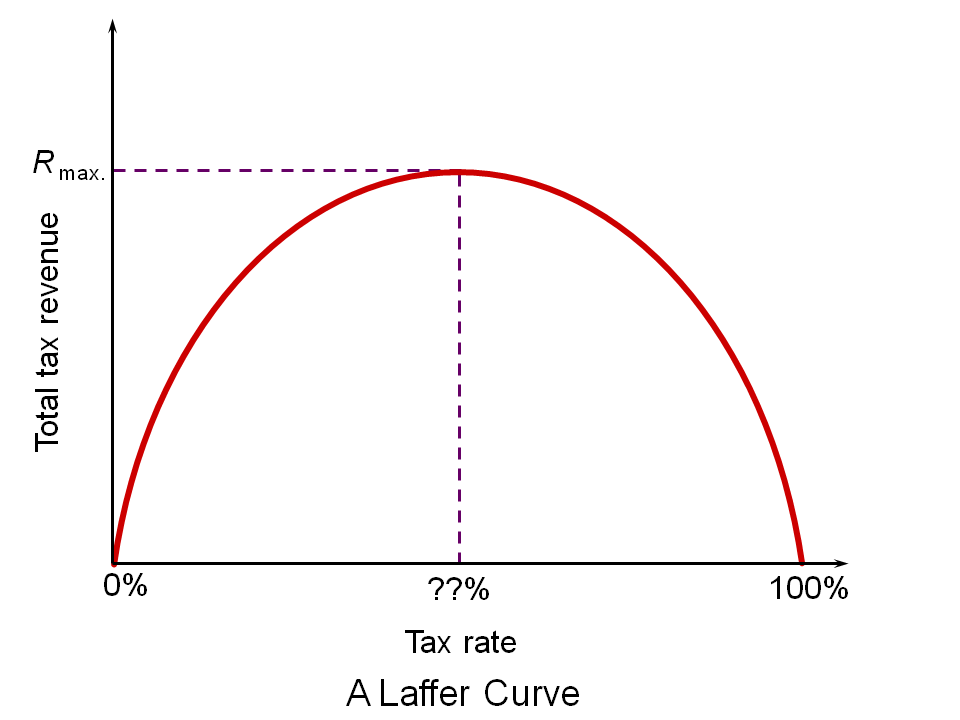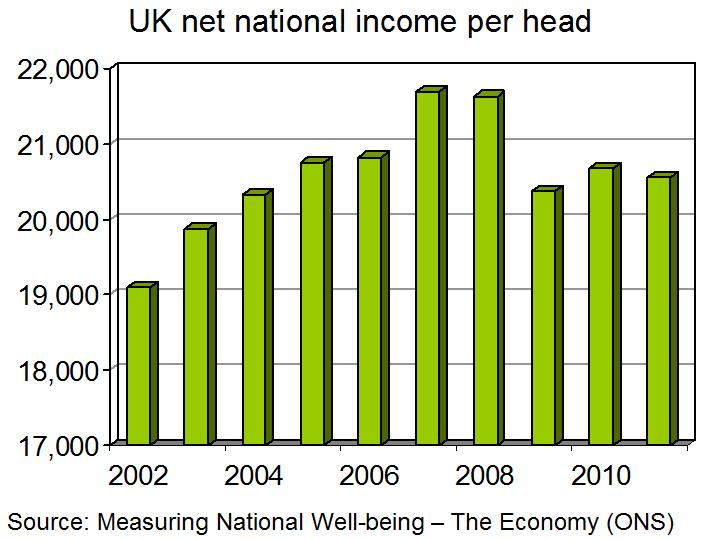 The UK Shadow Chancellor, Ed Balls, has announced that, if Labour is returned to power in the next election, it will bring back the 50% top rate of income tax (see also). This will apply to incomes over £150,000.
The UK Shadow Chancellor, Ed Balls, has announced that, if Labour is returned to power in the next election, it will bring back the 50% top rate of income tax (see also). This will apply to incomes over £150,000.
But will this raise more tax revenue? The question here concerns incentive effects. Will the higher rate of income tax discourage work by those earning £150,000 or encourage tax avoidance or tax evasion, so that the total tax take is reduced? The Conservatives say the answer is yes. The Labour party says no, claiming that there will still be an increase in tax revenue.
 The possible effects are summed up in the Laffer curve (see The 50p income tax rate and the Laffer curve). As the previous post stated:
The possible effects are summed up in the Laffer curve (see The 50p income tax rate and the Laffer curve). As the previous post stated:
These arguments were put forward in the 1980s by Art Laffer, an adviser to President Reagan. His famous ‘Laffer curve’ (see Economics (8th edition) Box 10.3) illustrated that tax revenues are maximised at a particular tax rate. The idea behind the Laffer curve is very simple. At a tax rate of 0%, tax revenue will be zero – but so too at a rate of 100%, since no-one would work if they had to pay all their income in taxes. As the tax rate rises from 0%, so tax revenue would rise. And so too, as the tax rate falls from 100%, the tax rate would rise. It follows that there will be some tax rate between 0% and 100% that maximises tax revenue.
As Labour is claiming that re-introducing the 50% top rate of income tax will increase tax revenue, the implication is that the economy is to the left of the top of the Laffer curve: that, at current level of income, the curve is still rising.
Work by HMRC, and published in the document The Exchequer effect of the 50 per cent additional rate of income tax, suggested that the previous cut in the top rate from 50% to 45% would cut revenue by around £3.5 billion if there were no incentive effect, but with the extra work that would be generated, the cut would be a mere £100 million. This implies, other things being equal, that a rise in the rate from 45% to 50% would raise only a tiny bit of extra taxes.
However, the HMRC analysis has been criticised and especially its assumptions about the incentive effects on work. Then there is the question of whether a rise in the rate from 45% to 50% would have exactly the reverse effect of a cut from 50% to 45%. And then there is the question of how much HMRC could reduce tax evasion and avoidance.
The following article from the Institute for Fiscal Studies examines the effects. However, the authors conclude that:
… at the moment, the best evidence we have still suggests that raising the top rate of tax would raise little revenue and make, at best, a marginal contribution to reducing the budget deficit an incoming government would face after the next election.
But there is also the question of equity. Putting aside the question of how much revenue would be raised, is it fair to raise the top rate of tax for those on high incomes? Would it make an important contribution to reducing inequality? This normative question lies at the heart of the different views of the world between left and right and is not a question that can be answered by economic analysis.
Article
50p tax – strolling across the summit of the Laffer curve? Institute for Fiscal Studies, Paul Johnson and David Phillips (Jan 2014)
Questions
- Distinguish between tax evasion and tax avoidance.
- How would it be possible for a rise in tax rates to generated less tax revenue?
- Could policies shift the Laffer curve as opposed to merely resulting in a move along the curve?
- What is meant by ‘taxable income elasticity (TIE)’? What are its determinants?
- Is the taxable income elasticity at the top of the Laffer curve equal to, above or below zero? Explain.
- Why did the Office for Budget Responsibility chairman, Robert Chote, conclude that, whatever the precise answer, we were ‘strolling across the summit of the Laffer curve’?
- Explain why ‘there is little additional evidence to suggest that a 50p rate would raise more than was estimated by HMRC back in 2012’.
- What contribution can economists make to the debate on the desirability of reducing inequality?
 Although every recession is different (for example in terms of length and magnitude), they do tend to have a few things in common. The focus of this blog is on consumer income and how it is affected in the aftermath of (or even during) a recession. According to data from the ONS, real national income per head has fallen by more than 13% since the start of 2008.
Although every recession is different (for example in terms of length and magnitude), they do tend to have a few things in common. The focus of this blog is on consumer income and how it is affected in the aftermath of (or even during) a recession. According to data from the ONS, real national income per head has fallen by more than 13% since the start of 2008.
This latest data from the Office of National Statistics shows that in the aftermath of the 2008 recession, UK incomes have fallen by much more than they did in the 2 previous recessions experienced in the UK (click here for a PowerPoint of the chart). We would normally expect consumer incomes to fall during and possibly directly after a recession, as national output falls and confidence tends to be and remain low. However, the crucial thing to consider with falling consumer incomes is how it affects purchasing power. If my income is cut by 50%, but prices fall by 80%, then I’m actually better off in terms of my purchasing power.

The data from the ONS is all about purchasing power and shows how UK consumer incomes have fallen at the same time as inflation having been relatively high. It is the combination of these two variables that has been ‘eating into the value of the cash that people were earning’. Comparing the incomes in the four years after the 2008 recession with similar periods following the early 1980s and 1990s recession, the ONS has shown that this most recent recession had a much larger effect on consumer well-being. Part of this may be due to the rapid growth in incomes prior to the start of the credit crunch.
It’s not just the working population that has seen their incomes fall since 2008 – the retired population has also seen a decline in income and according to a report from the Institute for Fiscal Studies, it is the wealthiest portion of older households that have taken the largest hit since 2007. According to the IFS, the average person over 50 has experienced a fall in their gross wealth of about 10%, or close to £60,000. Of course for these older households, the concern is whether they will be able to make up this lost wealth before they retire. The concern for everyone is how long until incomes and purchasing power increase back to pre-crisis levels. The following articles consider this latest data on economic well-being and the impact the recession has had.
UK wellbeing still below financial crisis levels Guardian, Larry Elliott and Randeep Ramesh (23/10/12)
National income per head ‘down 13% in four years’ BBC Newsd (23/10/12)
Financial crisis hits UK retirement income Financial Times, Norma Cohen (23/10/12)
Over 50s ‘left £160,000 out of pocket by the financial crisis’ The Telegraph, James Kirkup (23/10/12)
Those near retirement in UK hit hard by crisis Wall Street Journal, Paul Hannon (23/10/12)
Living standards down 13pc since start of recession The Telegraph (23/10/12)
Questions
- Why is net national income per head said to be the best measure of economic well-being?
- Why is it so important to take into account inflation when measuring wellbeing?
- What explanation can be given for the larger fall in consumer incomes following the 2008 recession relative to the previous 2 recessions?
- According to data from the IFS, the richest portion of older households have suffered the most in terms of lost wealth. Why is this the case?
- What is meant by purchasing power?
- GDP has fallen by about 7%, whereas national income per head, taking inflation into account is down by over 13%. What is the explanation for these 2 different figures?
- How can recessions differ from each other? Think about the length, the magnitude of each.
- Is GDP a good measure of economic well-being? Are there any other ways we can measure it?
Twice a year, directly after the government’s Spring Budget and Autumn Statement, the Institute for Fiscal Studies gives its verdict on the performance of the economy and the government’s economic policies – past and planned. This year is no exception. After the Chancellor had delivered his Autumn Statement, the next day the IFS published its analysis. And what grim reading it makes.
• Real average (mean) incomes in 2011 will have fallen by 3%.
• Between 2009/10 and 2012/13, real median household incomes will have fallen by 7.4%
• Over the same period, real mean household income will have fallen by 4.7% – easily the biggest 3-year drop since records began in the mid 1950s.
• Real mean household incomes will be no higher in 2015/16 than in 2002/03.
• The poorest will be hardest hit by the measures announced in the Autumn Statement.
• Infrastructure spending of £4bn to £5bn will only go some way offsetting the effects of £17bn capital spending cuts over the Parliament.
• The economy will be 3.5% smaller in 2016 than thought in March.
• The structural budget deficit is 1.6% higher than thought in March.
• That will extend to 6 years the period over which total spending will have been cut year on year.
Referring to this last point, Paul Johnson, director of the IFS, said in his Opening Remarks, “One begins to run out of superlatives for describing quite how unprecedented that is. Certainly there has been no period like it in the UK in the last 60 years.” Referring to the fall in real incomes, he said, “Again we are running out of superlatives to describe just how extraordinary are some of these changes.”
Commentators have referred to the “lost decade” where the average Briton will not have seen an increase in real income.
Articles
Autumn Statement 2011: Families face ‘lost decade’ as spending power suffers biggest fall since 1950s, says IFS The Telegraph, Matthew Holehouse (30/11/11)
Autumn Statement 2011: IFS talks down George Osborne’s growth plan The Telegraph, Philip Aldrick (30/11/11)
Autumn statement study by IFS predicts lost decade for UK living standards Guardian, Katie Allen and Larry Elliott (30/11/11)
Britons Enduring 13-Year Squeeze on Living Standards, IFS Says Bloomberg Businessweek, Gonzalo Vina (30/11/11)
The UK now faces a ‘lost decade’ Financial Times, Martin Wolf (29/11/11)
Warning of seven-year squeeze Independent, James Tapsfield, Andrew Woodcock (30/11/11)
Osborne’s impact laid bare: The rich get richer and the poor get poorer Independent, Ben Chu, Oliver Wright (1/12/11)
Incomes to fall 7.4% in three years, says IFS BBC News (30/11/11)
 No growth in income for 14 years, warns IFS BBC News, IFS director Paul Johnson (30/11/11)
No growth in income for 14 years, warns IFS BBC News, IFS director Paul Johnson (30/11/11)
 UK economy: Third worst year since the war BBC Today Programme, IFS director Paul Johnson (29/11/11)
UK economy: Third worst year since the war BBC Today Programme, IFS director Paul Johnson (29/11/11)
IFS Analysis
Autumn Statement 2011 and the OBR Economic and Fiscal Outlook IFS (30/11/11)
Questions
- Why is it likely that the median real income will have fallen by more than the mean real income?
- Why is the structural deficit now estimated to be some 1.6 percentage points higher than was estimated by the OBR back in March 2011?
- How could the structural deficit be affected by a prolonged recession? Is this a case of hysteresis?
- What are the government’s fiscal rules?
- Is the IFS predicting that the rules will be met? What might adversely affect this prediction?
- If technological progress is allowing a continuous increase in potential real GDP, why will median real incomes have fallen over the 13 years between 2002/03 and 2015/16? What might have affected long-term aggregate supply adversely?
 The UK Shadow Chancellor, Ed Balls, has announced that, if Labour is returned to power in the next election, it will bring back the 50% top rate of income tax (see also). This will apply to incomes over £150,000.
The UK Shadow Chancellor, Ed Balls, has announced that, if Labour is returned to power in the next election, it will bring back the 50% top rate of income tax (see also). This will apply to incomes over £150,000. The possible effects are summed up in the Laffer curve (see The 50p income tax rate and the Laffer curve). As the previous post stated:
The possible effects are summed up in the Laffer curve (see The 50p income tax rate and the Laffer curve). As the previous post stated:

